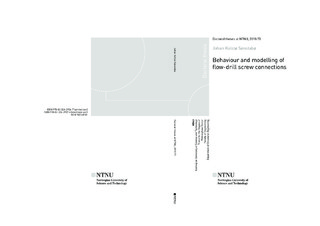| dc.contributor.advisor | Langseth, Magnus | |
| dc.contributor.advisor | Morin, David Didier | |
| dc.contributor.author | Sønstabø, Johan Kolstø | |
| dc.date.accessioned | 2018-03-28T10:11:02Z | |
| dc.date.available | 2018-03-28T10:11:02Z | |
| dc.date.issued | 2018 | |
| dc.identifier.isbn | 978-82-326-2937-4 | |
| dc.identifier.issn | 1503-8181 | |
| dc.identifier.uri | http://hdl.handle.net/11250/2492306 | |
| dc.description.abstract | This PhD thesis consists of experimental and numerical studies of the behaviour and modelling of flow-drill screw connections. It is comprised of four parts, and each part has been published, or accepted for publication, in scientific peer-reviewed journals. As such, each paper may be read independently. The papers are preceded by a synopsis that brings each part into a broader perspective, states the motivation, objectives, scope and research methodology of the work, and provides a summary of the work. A brief case study is presented at the end of the synopsis.
Paper 1 is a purely experimental investigation of the behaviour of a flow-drill screw connection between sheets of aluminium alloy AA 6016 T4. Different quasi-static loadings were studied using cross, single lap-joint and peeling tests. This provided knowledge about the global force-displacement behaviour of the connections, as well as different deformation and failure modes. The paper also contains axial crushing tests of single-hat sections, joined with flow-drill screws. These tests were dominated by material deformation outside of the connections, which made it difficult to evaluate the connection behaviour.
Paper 2 addresses macroscopic modelling of flow-drill screw connections in large-scale finite element simulations. Five common models were studied, of which two were element-based and three were constraint-based. They were evaluated for two different connections. The two element-based models did not perform well, as they over-estimated the force in mixedmode loadings. The constraint-based models yielded better results. One stood out as marginally better, appearing to be the most suited, of the five models, to represent flowdrill screw connections.
Paper 3 deals with a detailed numerical model of a flow-drill screw connection, where the geometry of the connection was discretised with a fine solid element mesh. Five different tests were simulated, and the results compared to equivalent experimental tests. A microstructure analysis and Vickers hardness tests indicated that there was a processaffected zone close to the screw. Despite that process effects were neglected in the numerical model, satisfactory results were achieved. The simulations provided a deeper understanding of the underlying deformation and failure mechanisms.
Paper 4 presents a component suited for quasi-static and dynamic testing of flow-drill screw connections, of which the design is such that the dominating deformation is taking place in the connections, and at the same time has relevant and sufficiently complex loadings in the connections. Large-scale simulations were carried out, where the preferred model in Paper 2 was employed at the connections. An improvement of the connection modelling technique was presented. The component was well-suited for validation of large-scale finite element models. | nb_NO |
| dc.language.iso | eng | nb_NO |
| dc.publisher | NTNU | nb_NO |
| dc.relation.ispartofseries | Doctoral theses at NTNU;2018:73 | |
| dc.relation.haspart | Paper 1:
Sønstabø, Johan Kolstø; Holmstrøm, Petter Henrik; Morin, David; Langseth, Magnus.
Macroscopic strength and failure properties of flow-drill screw connections. Journal of Materials Processing Technology 2015 ;Volum 222. s. 1-12
https://doi.org/10.1016/j.jmatprotec.2015.02.031 | |
| dc.relation.haspart | Paper 2:
Sønstabø, Johan Kolstø; Morin, David; Langseth, Magnus.
Macroscopic modelling of flow-drill screw connections in thin-walled aluminium structures. Thin-walled structures 2016 ;Volum 105. s. 185-206
https://doi.org/10.1016/j.tws.2016.04.013 | |
| dc.relation.haspart | Paper 3:
Sønstabø, J. K., Morin, D., and Langseth, M. “Testing and modelling of flow-drill
screw connections under quasi-static loadings”
© 2018 This manuscript version is made available under the CC-BY-NC-ND 4.0 license http://creativecommons.org/licenses/by-nc-nd/4.0/
Publisher version available at
https://doi.org/10.1016/j.jmatprotec.2018.01.007 | |
| dc.relation.haspart | Paper 4:
Sønstabø, J. K., Morin, D., and Langseth, M. “Static and dynamic testing and
modelling of aluminium joints with flow-drill screw connections.” International
Journal of Impact Engineering 115 (2018), pp. 58-75.
https://doi.org/10.1016/j.ijimpeng.2018.01.008 | |
| dc.title | Behaviour and modelling of flow-drill screw connections | nb_NO |
| dc.type | Doctoral thesis | nb_NO |
| dc.subject.nsi | VDP::Teknologi: 500::Bygningsfag: 530::Konstruksjonsteknologi: 533 | nb_NO |
| dc.description.localcode | Digital full text not available | nb_NO |
